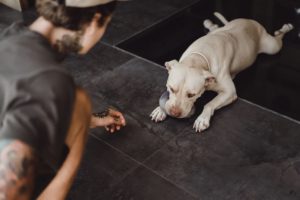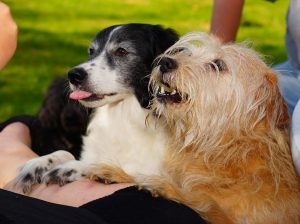Ask Crystal: Old Dog, New Tricks?

Dear Crystal,
My cockapoo Abby is 9 yrs old and was raised with our other cockapoo who passed a few years ago. She was the friendliest dog and loved other dogs and people. Abby on the other hand doesn’t like kids and other dogs (I think she is afraid of them). Is there a way to train her to adapt to kids and other dogs at this stage of her life?
Sincerely,
Cockapoo Mom
Dear Cockapoo Mom,
What a wonderful world it would be if all of our dogs loved interacting with all people and other dogs. Unfortunately, that is not the case for many dogs. Dogs just like humans have things that they don’t like or make them uncomfortable.
Reasons Dogs May be Afraid
There are many reasons why a dog might be more fearful of children. To dogs, children obviously look different than adult humans. And toddlers and babies have movements that are quite different from an adult. They may stumble or fall down frequently. Children often tend to run around quickly and/or jump or stomp which can be frightening to a dog. Younger children may yell loudly, scream, squeal, or cry which can startle a fearful dog.
Children also tend to invade a dog’s space. They may hug, kiss, lie on, lean on, or try to ride a dog. Dogs have personal space in the same way that humans do. Children also may try to pet a dog in a way which is threatening to the dog, such as reaching over their head. Many dogs will tolerate a behavior initially but then become frustrated if the behavior continues. This can lead to aggressive response behaviors from the dog and to a general dislike of all children.
Even if you don’t have children living in your home, there are probably going to be times when your dog is going to encounter children. It is a good idea to plan ahead how you will handle those situations. There are some basic cues to teach the dog so you can have some control and the dog will be responsive to you. Learn dog body language so that you can read your dog and know when he is feeling uncomfortable.
Think of the various situations in your life in which you might encounter children. You will need to be able to be your dog’s advocate and stop children who are running up to your dog. You must be proactive enough to tell people that your dog is not comfortable being petted. Your dog needs to trust that you will protect them in these situations. Do not try to force the dog to face its fears by having children pet them. This technique is referred to as flooding and it is not an appropriate training technique. It puts your dog over their comfort threshold and puts them at risk to bite. Similarly, do not ask children to come up and feed your dog treats. Some dogs will approach a person to take a treat and then realize that they are closer to the person than they are comfortable with. These dogs may snap or bite after they eat the treats.
Canine and Child Interactions
If you have guests in your home with children, how will you manage that situation? Consider the severity of your dog’s behavior when creating a management plan. If your dog shows only mild discomfort with children or has mild handling issues, you could have the dog behind a baby gate. You may choose to keep the dog in a crate or guest room with the door locked. If the children are very young, consider crating the dog as kids often open doors. You should work on teaching your dog to accept the crate before you ever have guests come over so that she won’t be distressed. You may want to give the dog a food toy to keep them entertained. A dog that shows aggressive behavior or has a bite history should be kept safely away from children. If the dog shows only mild discomfort around children, allow the dog and child together only when adults are 100% paying attention to the children and the dog and be sure the children have been taught how to interact.
 Children need to learn the proper way to approach and pet a dog. They should not run up to a dog. It is best to stand sideways to the dog and pet it along the back or on the neck. Dogs don’t usually enjoy being petted on top of the head. People of all ages should always be checking in with the dog to make sure he enjoys the petting.
Children need to learn the proper way to approach and pet a dog. They should not run up to a dog. It is best to stand sideways to the dog and pet it along the back or on the neck. Dogs don’t usually enjoy being petted on top of the head. People of all ages should always be checking in with the dog to make sure he enjoys the petting.
Observe the Three Second Rule when petting all new dogs:
- Pet a couple strokes for no longer than 3 seconds and then move your hand away.
- If the dog doesn’t interact or moves away, stop petting.
- If he nudges you or engages you for more, continue petting.
Stress Signals
Dogs have many body language signals which indicate stress or discomfort. Many signals can have more than one meaning so we should look at the dog’s behavior as whole. Often, these signals will appear concurrently or in succession:
- Avoidance
- Yawning
- Scratching
- Shake-offs
- Lip-licking
- Turning the head away
- Slow movement
- Stiffness
- Whale eye
- Mouthing
- Hyperactivity
- Excessive grooming
- Shaking
- Panting
- Whining
This list is not exhaustive.
Most people can recognize larger signals such as growling, snapping, lunging, and biting, but there were most likely several smaller signals which preceded those larger, aggressive signals. When a dog’s subtler signals are ignored, they must resort to more aggressive behaviors.
Distraction Training

There are some basic training cues which will help your fearful dog when you encounter children. Teach her an auto-check in for anything that makes her nervous. This will teach the dog to look to you and you can then engage her in an alternative behavior while the kids pass. This may also help them to develop a more positive association with children being around if they enjoy training. “Find it” is a great game to get a dog’s nose engaged with sniffing the ground. This way she won’t pay attention to the children and sniffing is a relaxing activity. You may want to teach your dog a “go to place” cue to keep them on their bed while children are in your home. This is only suitable for dogs that haven’t bitten and children that understand not to approach a dog on its bed.
Be Your Dogs Advocate
It’s important that first and foremost, we are our dog’s advocate. We don’t put them in situations that make them feel uncomfortable. We know how to read body language so that we can see when they are uncomfortable and get them out of the situation. Any children that are interacting with our dogs should be closely watched and coached on the proper ways to interact and stopped when they aren’t listening, or the dog is becoming more uncomfortable. A lot of the reason dogs act aggressively is because no one is listening to what they are trying to tell them, and they feel that they must increase the intensity of their reaction to get your attention. If your dog knows that you are there to protect them and respond when they need help, they will feel less likely to overreact.
Dog to Dog Interactions
In regard to the other dogs, since you don’t say specifically what she is doing, it’s hard to give any sort of prognosis. I can say that dogs often become more selective with who their dog friends are as they get older. Puppies are usually dog social which means they will happily play with just about any dog. As they age, they develop preferences based on socialization, experience and a genetic component.
 It may be that she can have a couple dog friends that she hangs out with occasionally. She can probably live with another dog again providing that you take the introduction slowly with the assistance of a Certified Professional Dog Trainer if you aren’t familiar with how to set that up. I personally see no reason to expect our dogs to interact with every dog they see. It is often very stressful for the dog and most of the times these interactions are on leash which makes the dog feel like they have no way to get away and they react aggressively to proactively protect themselves. Again, we want to be our dog’s advocate and watch their body language. If they don’t want to interact, we don’t force it. We have to learn how to tell people, “No, my dog doesn’t want to say hello.”
It may be that she can have a couple dog friends that she hangs out with occasionally. She can probably live with another dog again providing that you take the introduction slowly with the assistance of a Certified Professional Dog Trainer if you aren’t familiar with how to set that up. I personally see no reason to expect our dogs to interact with every dog they see. It is often very stressful for the dog and most of the times these interactions are on leash which makes the dog feel like they have no way to get away and they react aggressively to proactively protect themselves. Again, we want to be our dog’s advocate and watch their body language. If they don’t want to interact, we don’t force it. We have to learn how to tell people, “No, my dog doesn’t want to say hello.”
There are ways to condition dogs to change their emotions around things that make them fearful but it can be difficult and time consuming so I would ask how important it is that you change her feelings about kids and other dogs. It is a lot of work and especially difficult to make changes when the dog has been doing the behavior or feeling the emotions for this long of a time. Old dogs can learn new tricks, but it is harder to change behaviors that have been there for a long time. If it is really important to change her opinion on children and/or other dogs to you, contact a Certified Professional Dog Trainer to help you create a training plan. Locate one here.
Until next time,
Crystal







